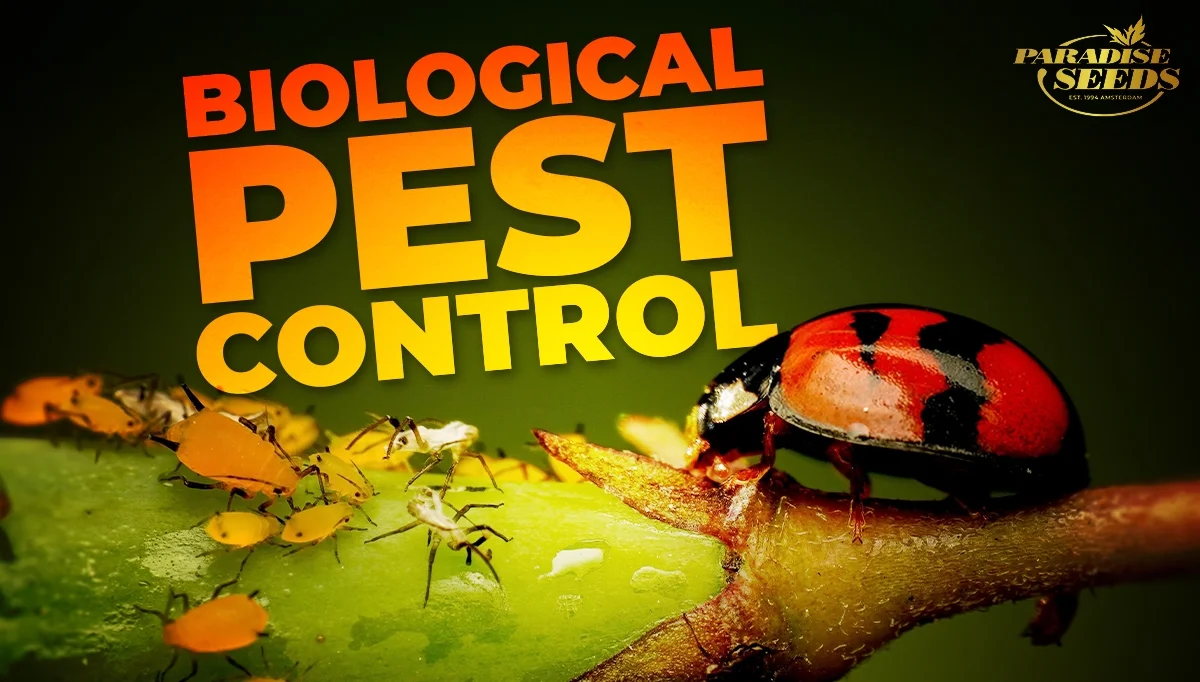Every outdoor cannabis grower knows that sense of panic when they discover an unwanted visitor on their plant. Often the evidence comes in the form of leaf damage – discoloration or tiny holes and nicks in the surface of the leaf. It’s the horrible realization that a predator is munching away on your beloved plant…
First of all, don’t panic. If you are a good and diligent grower, the chances are you will catch the early signs which means that you have a good chance of fixing the problem. Second of all, don’t reach for the chemicals (even if they claim to be “safe”). While they offer the lure of a quick hit, ‘nuking’ your plant is not a solution we would advise. Part of the Paradise mantra is to grow as organically as possible – after all, at the end of this process the product is ready for human consumption and you don’t want to be ingesting any of that quick hit toxic crap! Instead seek out biological pest control solutions for your cannabis plants.
Work With Nature
One of the occupational hazards of sowing your cannabis seeds and growing outside is that you have to deal with what nature throws your way. The indoor cannabis grower has it easy in this respect – a controlled environment that is easily managed. On the flipside, the arrival of a pest in an indoor environment is more of a concern as there is only one way in and out. In nature, while pest visitations can be more common, with the right management they are not so devastating.
We have seen many examples of outdoor plants which have survived an attack by red spider mites in dry, summer conditions and still produced good harvests. Part of this has to do with good genetics – strains such as Spoetnik #1 , Original White Widow IBL and Durga Mata have in-built pest resistance qualities – but also to do with working with nature.
With the arrival of an identified pest (this will require using a magnifying glass to assess the nature of the pest and damage) the outdoor cannabis seed grower is advised to reach for biological control. There is a whole selection of predator insects ready to feast on your problem! While the arrival of little predator pouches can be a little disappointing (ie you can’t see anything because they are so small!), don’t be put off because introducing these predators into the food chain will help control your problem.
It is important to note here, that even if the predators don’t wipe out your pest completely, they will be waging a war that will prevent your pest problem from becoming terminal for your plants. There are many companies offering biological pest control solutions for cannabis, as well as other plants. Some are preventative (ie if you know you have a recurring issue with a pest), while others are reactive pest treatments.
3 Common Cannabis Pests and Biological Pest Control Predators to Fix Them..
Here are some of the more common pests and the recommended biological pest control solutions for cannabis plant health:
Aphids are a worldwide cannabis problem and they are attracted to cannabis plants, where they will feast on the juices of cannabis leaves, causing leaf damage and discoloration and potentially issues with mold which attaches to the damage. Perfect predators for aphids are Aphidius and Aphidoletes – their natural enemies.
Thrips are yellow/white in appearance and tiny. They destabilize the cannabis plant by sucking on the sap of the leaves. To get rid of a thrip problem call in the cavalry in the form of the following predators – Amblyseius cucumeris and every small child’s favourite red with black spotted insect, the ladybug.
Red spider mites are also sap eaters and can cause mottled leaves (and also leaf loss). If the colony takes hold, webs will appear on the plants (and by then it is too late). However, introducing biological pest control predators such as Phytoseiulus persimilis .
The best way to keep on top of any pest problem is to pay careful attention to your plants and watch for early signs that something may be wrong. For this task a magnifying glass or jeweller’s loupe is an essential piece of kit for any cannabis grower as these pests are small. Catch pest issues early however, and nature has the weapons to deal with the problem before it gets out of hand.


